It struck me that perhaps, and I do not know this for sure of course, one factor behind this disaster might have been that none of these experts will have had much education in how to work together with others online to solve problems. Existing education systems focus almost exclusively on developing individual knowledge and indivdiual ability to perform well in examinations, they do not spend much effort if any on developing collective intelligence. Deepwater Horizon was an extreme event but having to work together with geographically distant others online to solve problems is now an aspect of every professional job.
Learning to Learn Together Online (L2L2O) is becoming essential in every area of life. Our recent experience of scientists and policy makers from every country around the world collaborating to defend the human race against the COVID 19 pandemic is a striking example. The recent successful global collaboration against the threat of a hole in the ozone layer and the need now for collaboration to counter the challenge of global warming indicate that education for collective intelligence is not just something useful for small teams, it may be essential for all of us now if we - the human race as a whole - are to survive and continue to thrive.
What is 'Collective Intelligence'?
A lot of work on measuring individual human intelligence in psychology has led to a focus on 'g factor', described as the overlap between ability on a range of tests. In other words intelligence is understood as general thinking ability, not just being good at one task but being generally good at learning new things and solving new problems in a range of different contexts. This is interesting because, if we follow this definition, it is clear that Artificial Intelligence (AI) is still just a fantasy. We have clever tools built to do specific tasks efficiently but as yet no software that shows an ability to think well generally across a range of domains and tasks. On the other hand we do have evidence of general intelligence for groups. Instead of focussing so much energy on the fantasy of autonomous AI machines we might do better to focus our efforts on the much more real and effective intelligence that we know we can achieve through combining smart technology with human groups.
Anita Woolley and a team at MIT investigated lots of different groups doing lots of different kinds of tasks and came up with what they claimed to be a robust measure of group intelligence which they called 'c':
By analogy with individual intelligence, we define a group’s collective intelligence (c) as the general ability of the group to perform a wide variety of tasks. Empirically, collective intelligence is the inference one draws when the ability of a group to perform one task is correlated with that group’s ability to perform a wide range of other tasks (Woolley et al 2010)
Teaching for group intelligence
For many years now I have been working with colleagues to develop and evaluate ways of teaching for collective intelligence. The Cambridge Educational Dialogue Research Group (CEDIR) and the Cambridge Oracy Centre have many tried and tested resources to promote effective group 'thinking together' (try https://thinkingtogether.educ.cam.ac.uk/) and some of these resources are also available in Spanish and in Mandarin Chinese (email CEDIR from their website).
Here are a couple of books that give guidance on how to teach for collective intelligence:
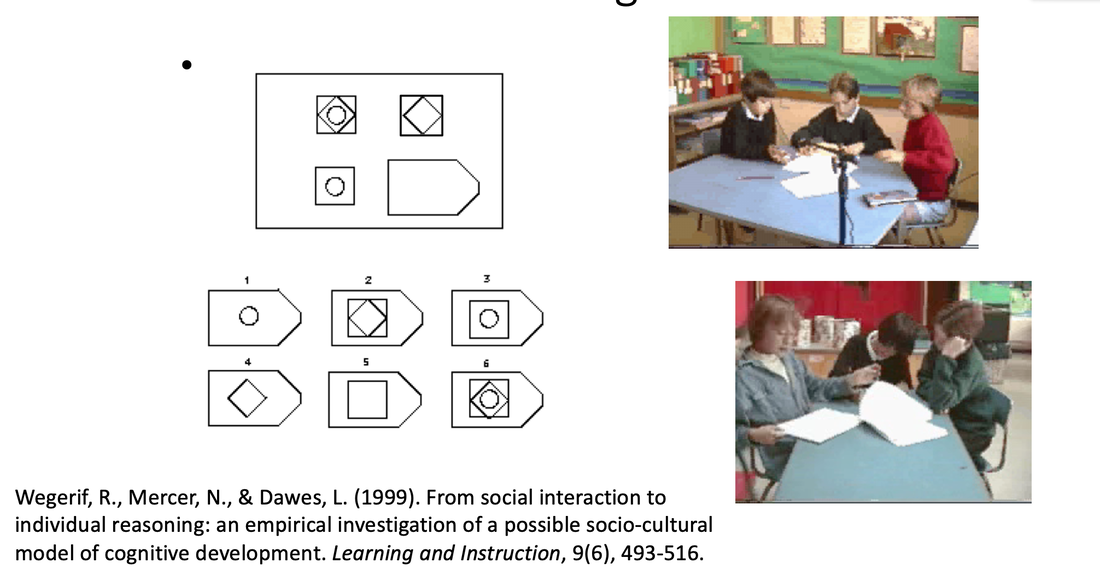
A recent study of group intelligence with adults
Most of our research has been with children but the approach to measuring collective intelligence also works with adults. Marcelo Pizarro in Chile is an expert on measuring intelligence. Recently, working with me, he compared groups and individuals on standard IQ tests. The sample size was 48 adult students. 2 equivalent standard IQ tests were used, FIXA and FIXB. In the collaborative condition groups of three students worked together online using zoom.
These groups of three did better than individuals with an effect size of 0.933 which is large.
While groups generally did better than individuals, some groups did much better than other groups. Looking at the videos of the interactions we could see that good humor played an important part. Marcelo's hypothesis is that good humor helps groups to manage cognitive conflict. It is difficult for us to challenge the views of people we do not know very well. It is embarrassing. But where there is a good group feeling the danger of this kind of conflict between ideas can be contained. This perhaps explains why, when there is joking and laughter groups can think together better.
Marcelo writes that:
the individuals of the sample had an IQ that was average (103~ or 58 percentile), but when they were working on groups, they obtained scores that, depending on the comparison, were either on the upper edge of the average range (112~ or 78 percentile) or well above the average range (134~ or 99 percentile). People with “average” abilities can perform well above their capabilities when working with others. I think this has great implications for education and the workplace.
Our continuing research into what makes for successful group intelligence confirm Marcelo's claims about humour:
- Encouraging each other, for example responding to suggestions with ‘could be …’
- Expressions of humility, for example ‘I do not understand this.’
- Giving clear elaborated explanations, for example ‘the triangle here is removed and here it turns around by 90 degrees’
- Equal participation with everyone in the group actively involved in each problem.
- Humour with jokes and shared laughter.
- Willingness to express intuitions, for example, ‘I am not sure but I have a feeling it is that one’
- Indications of mutual respect in tone and responses.
- Taking time over solving problems seen in accepting pauses and giving elaborated explanations when asked.
Augmenting Collective Intelligence with smart tools
Thinking together in small groups is a good start but it is not enough. For many problems we also need to get larger groups thinking together. This is where smart tools might be of particular benefit.
If you think about it, we have always had technology supported collective intelligence. Both literacy and mathematics are technologies that have supported large scale collective thinking. Writing thing down enables ideas to be shared across space and it also enables collaboration in thinking over time. Collective Intelligence supported by technology has been behind all of our successes in science and technology as well as in art and philosophy. However, much of this collective intelligence has emerged in an apparently random or spontaneous way. The question is, 'is it possible to design for collective intelligence?' More pertinently, 'is it possible to design education plus communications technologies to be better at supporting both small group thinking and larger scale collective thinking?'
Below I offer a few examples of how smart technology has been used to support collective intelligence before going on to show how smart technology can be used to support education for collective intelligence.
Swarm-AI and Pol.is - bringing people together
Social media platforms such as Facebook and Twitter seem to reward the more extreme views and so are said to lead to polarisation. Several software systems have now been developed to do the opposite, bringing people back together.
Swarm AI is one example. Swarm intelligence algorithms moderate the interaction of a group of individuals who are deciding between a set number of options. Individuals connect with each other and AI agents to form a closed-loop system where both the machine and individuals can react based on the behaviour displayed by others to change or maintain their preference. This collective 'thinking together' approach, modelled on the way that some animals 'swarm' together, has been shown to improve decision making in a range of areas.
(https://www.nesta.org.uk/feature/ai-and-collective-intelligence-case-studies/swarm-ai/)
Pol.is is another AI supported online debate and decision-making system that already has many examples of success.
Pol.is produces a map of where people are in any dialogue. As a result they can see if they share opinions or if they are at an extreme. The result is to encourage people to find common ground and converge on a shared solution through dialogue that involves deepening their understanding of key divisive issues and seeking creative emergent solutions that as many as possible can buy into.
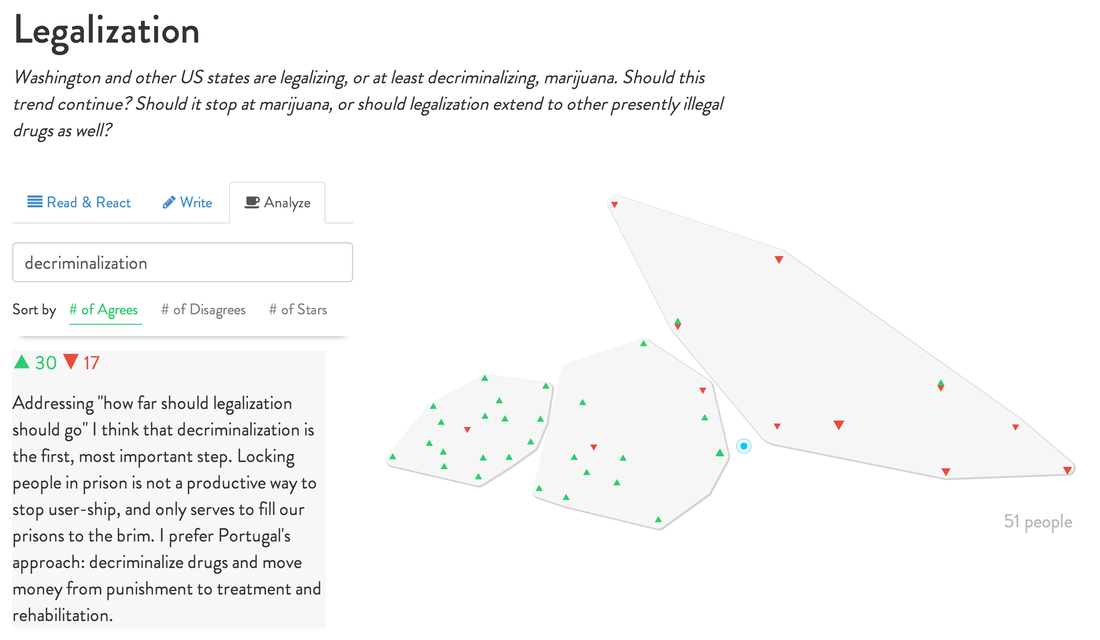
Here is an example of polis in action taken from https://www.geekwire.com/2014/startup-spotlight-polis/
Pol.is has been used in many contexts now including to support improved democratic decision making in Taiwan where it was introduced by digital minister, Audrey Tang. (https://hbr.org/podcast/2020/10/how-taiwan-is-using-technology-to-foster-democracy-with-digital-minister-audrey-tang)
How Pol.is really works is I think closely related to how dialogic identity expansion works. When an individual writes an opinion in a Pol.is debate that individual is naturally focused on what they think coming out of their experience. However, stepping back and looking at the map that situates their input in relation to all the others, they naturally then are forced to take on the perspective of the dialogue as a whole. What develops from this is a more dialogic identity, both my voice on the inside talking outwards but also seeing or hearing the perspective of the dialogue as a whole, as if from the outside looking inwards to define and locate my voice as just one voice amongst others. In this process the individual does not lose their identity in the collective but they expand their sense of identity to take into account the point of view of the collective. They become more dialogic selves - double-voiced - where self now is not a 'thing' but a continuous dialogue between inside and outside points of view. Shifting from either ego based identity (I need to win the argument) or collective based identity (group harmony must not be disturbed) into a more dialogic identity (I can see both sides) is a key aspect of successful group thinking.
(see https://www.rupertwegerif.name/blog/what-is-a-dialogic-self)
Edubots, guiding and focussing the dialogue
Edubots, artificial conversational agents used as tutors, have been shown to have a useful role in supporting online learning dialogues. Bots can be used to welcome people, invite them together into groups, tell bad bot jokes to warm them up, challenge them to think more clearly, invite quiet participants to speak more and generally police and improve the educational quality of interactions. Edubots might be a valuable support for collaborative learning in MOOCs or Massive Open Online Courses (see review in Tegos, S., Mavridis, A., & Demetriadis, S. (2021). Agent-Supported Peer Collaboration in MOOCs. Frontiers in Artificial Intelligence, 4 https://www.frontiersin.org/articles/10.3389/frai.2021.710856/full)
Metafora: Learning to learn together
(https://www.researchgate.net/publication/289619416_The_metafora_tool_Supporting_learning_to_learn_together)
Argunaut: An Intelligent Guide to Support Productive Online Dialogue
We coded the quality of dialogue in our dynamic concept mapping environjent (Digalo) as follows:
- critical thinking with its focus on claims, counterclaims and reasons (D1)
- creative reasoning understood as a sort of dance of perspectives (D2)
- dialogic engagement which includes not only addressivity and expressions of empathy but also expressions of doubt, changes of mind, ventriloquation (the presence of another voice within an utterance) and elicitation of the views of others (D3).
- moderation through encouragement and the scaffolding support of recapitulations, reformulations and evaluations (D4).
Using data-mining techniques including natural language processing we were able to get robust automatic coding of both reasoning and creativity (Work led by Bruce McLaren of Carnegie Mellon). In the shallow loop of Argunaut the moderators could see quality indicators and intervene with a series of comments. The idea of the deep loop of Argunaut was that the quality indicators were constantly being evaluated and improved as were the guiding comments. This would have depended on a large community of users and we did not get beyond basic proof of concept but the idea is exciting.
Imagine you are an online teacher with 20 or 100 groups of 5 to 8 students. You have a dashboard that enables you to visit each group and make suggestions. Natural language processing datamining (AI) tells you indicators that might relate to the quality of interaction occurring in each group and suggests a prompt into the room eg ‘could you see this differently?’ or ‘what do you think, John?’. You could look in more detail at the group before deciding or not to intervene with a comment or you could let the machine decide for you. The impact of each such intervention is monitored by AI and fed back to constantly improve the overall performance of the system.
https://www.researchgate.net/publication/228479459_Facilitate_the_facilitator_Awareness_tools_to_support_the_moderator_to_facilitate_online_discussions_for_networked_learning
Research agenda
Most of the research referred to as ‘AI in education’ is about accelerating individual learning using data-analytics and data-mining techniques to provide adaptive personalized learning trajectories. That has been done. What we need to do now is research how to use similar smart technologies to support collaborative learning and to teach for collective intelligence.
The examples I have given in this blog show the huge potential of technology to support better collective thinking and to support education for better collective thinking. But they barely scratch the surface of the research and development that is needed.
The following are just a few ideas for research projects in increasing magnitude, it is not meant to be exhaustive, do please send me further ideas as comments to this blog. I am suggesting this as part of the research agenda for the new Digital Education Futures Institute at Hughes Hall, Cambridge https://www.deficambridge.org/
- We need a thorough scoping review of digital technology used to support collective intelligence in education. More than a review, also finding the areas of cutting edge development and interviewing projects leaders. Both horizon scanning and beyond the horizon scanning.
- We could use Educational Design-Based Research (EDBR) on teaching thinking together off-line combined with moderated small group learning of specific concepts in areas of the curriculum online. I am thinking Edubots facilitating learning dialogues in small groups possibly with some content knowledge to help select examples and some learning to constantly improve dialogues. Measures could be specific conceptual learning and also communication and dialogue skills
- Develop the Argunaut deep-loop idea to improve machine awareness of and teaching for the educational quality of talk in small groups online.
- Using tools like the Metafora visual language, in combination with teaching thinking together, to support challenge-based learning using challenges such global warming. The aim would be to raise awareness as well as to teach how to work in teams to solve problems and how to think like a scientist. If groups were selected from different regions a further aim would be global citizenship.
- Develop a global platform to support education for developing our planetary collective intelligence. An education platform that anyone, anywhere with a smart phone could join, learn basic dialogue skills in small groups online or offline and then be led to join others in inquiring together into those challenges that most interest them. Every challenge would be supported by Open Education Resources with content knowledge. This would be a way to explore the possibility and potential of a different kind of education system, a global education system oriented towards preparing students to participate in designing the future.
Our current mainstream approach to education is not producing the collective intelligence that we need to solve the challenges of the future. The curriculum in most schools seems to me to be a bit like a person walking backwards into the future barely able to see the threats and opportunities ahead of them because their attention is focused firmly on the past. Each bit of knowledge and each discrete skill transmitted in the curriculum must have been useful to somebody once or it would not be there but that is no guarantee that this bit of knowledge or this particular skill will continue to be useful.
Is it possible to turn this system around to face forwards, inducting students from the beginning of their lives into dialogues about the future and equipping them with the skills and the knowledge that they need to participate constructively in building that future?
This is what designing education for collective intelligence means. We have some good ideas about how to start to do this but we cannot be sure what will work or what might be the unintended side-effects of new approaches. What we need now are careful design experiments, trying out new approaches to education supported by smart tools and seeing how they work out. That is what @defi_Cambridge is trying to do. Do let us know if you think you can help.
Wegerif, R., Mercer, N., & Dawes, L. (1999). From social interaction to individual reasoning: An empirical investigation of a possible socio-cultural model of cognitive development. Learning and instruction, 9(6), 493-516.
Wegerif, R., Fujita, T., Doney, J., Linares, J. P., Richards, A., & Van Rhyn, C. (2017). Developing and trialing a measure of group thinking. Learning and Instruction, 48, 40-50.
Woolley, A. W., Chabris, C. F., Pentland, A., Hashmi, N., & Malone, T. W. (2010). Evidence for a collective intelligence factor in the performance of human groups. science, 330(6004), 686-688.
Hogan, M. (2020). Collective Intelligence in Medias Res: Mulgan, Warfield, and the Collective Intelligence Network Support Unit (CINSU).
Tegos, S., Mavridis, A., & Demetriadis, S. (2021). Agent-Supported Peer Collaboration in MOOCs. Frontiers in Artificial Intelligence, 4.
https://www.deficambridge.org/

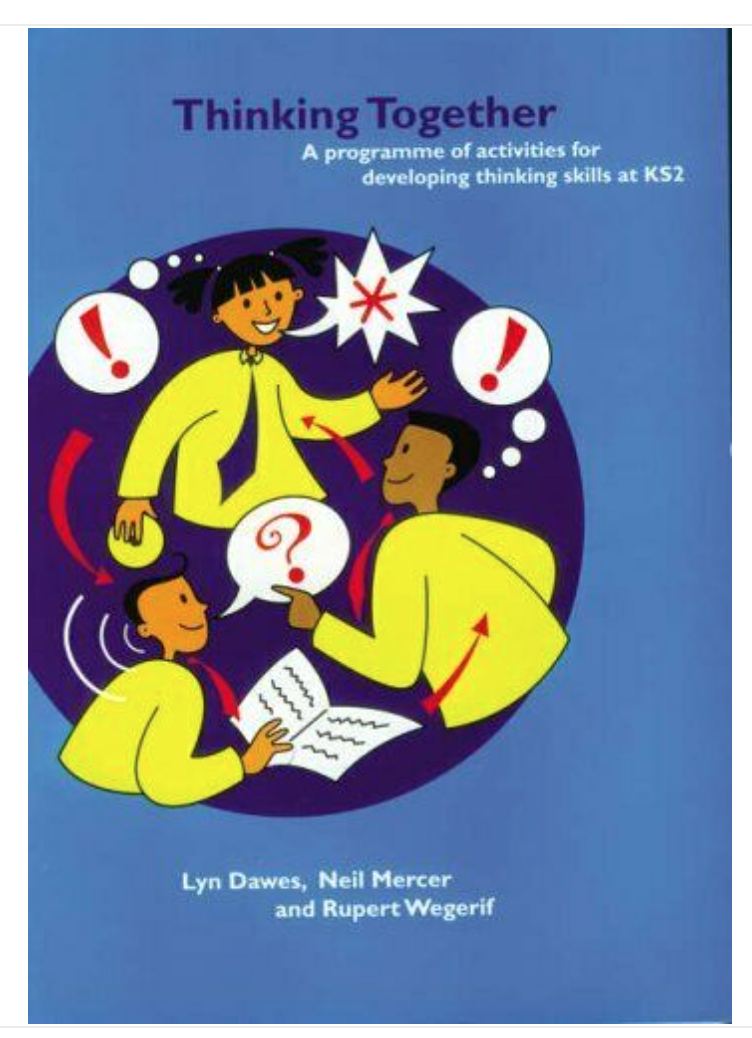
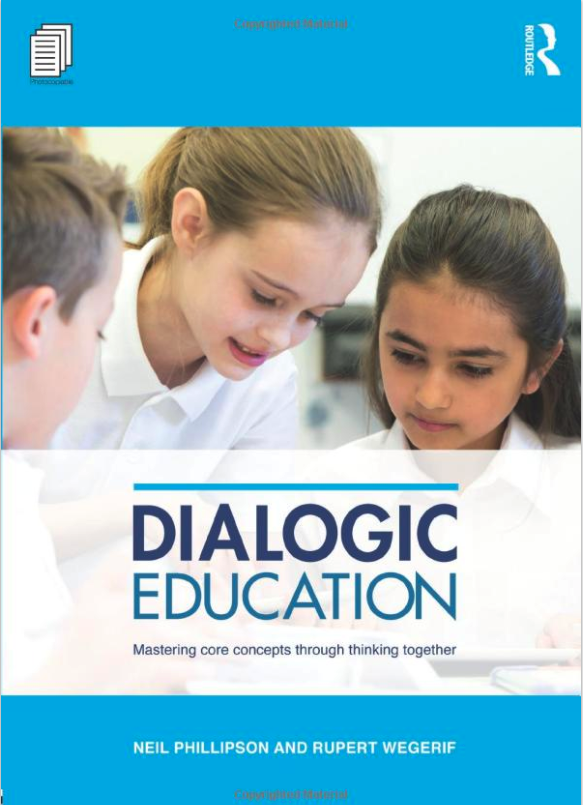
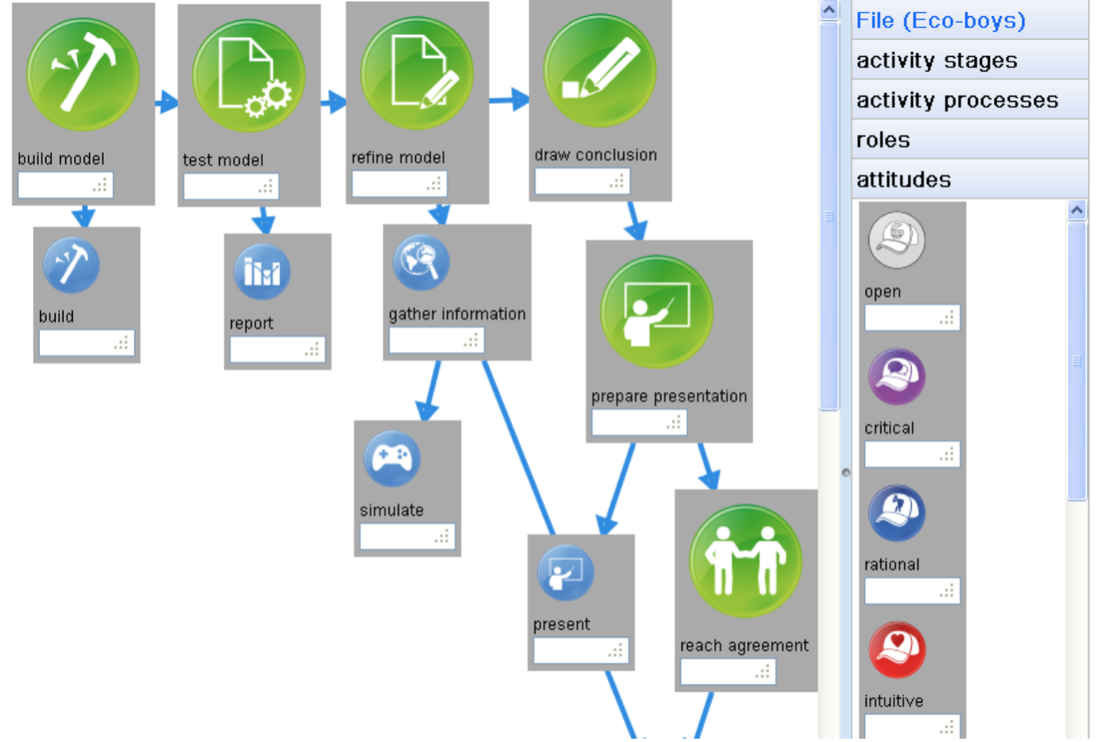
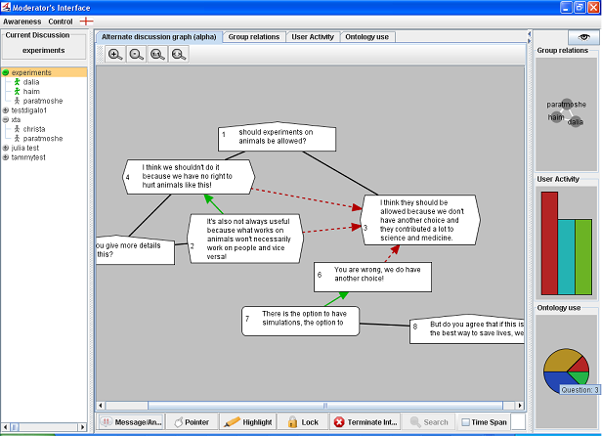

 RSS Feed
RSS Feed